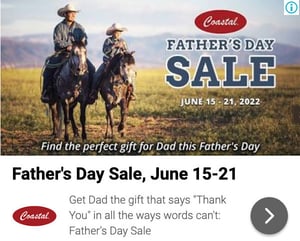Digital Ad Design
Best Practices
If you’re struggling to understand how to design digital ads across different platforms that attract your audience in the best way, here’s the secret:
There’s more to creating successful digital ads than targeting the perfect audience and saying the right things. Without an effective design strategy to pair, there’s a lot of good results you could be missing out on. It is most important to understand the platform you are designing an ad for. Every social media platform has a different way of using and displaying ads. Knowing all of those different elements is crucial for designing a great ad every time.
Use this guide to help you create professional, well-designed digital ads for platforms like Facebook, Instagram, YouTube, and Google. This will include insight on both photo and video ads.
BEFORE YOU START
It is very important to have a good idea of what the goal of your ad is and what emotions you are trying to convey. You want your audience to feel some kind of way after seeing your ad; you want to make them feel that buying your product/service will make them feel better in some necessary way. In today’s digital world, potential customers encounter many different ads every day. So the question is, what can you do to stand out from the rest?
We are going to break it down for you by platform, because each one is unique in their own way and strategies can/should be adapted to those differences.
INSTAGRAM & FACEBOOK – PHOTO ADS



Aspect ratio. The best aspect ratio to consider is either 1:1 or 1.91:1 for in-stream ads; 9:16 for Story ads. These sizes ensure that your ads will be optimized for mobile use. Be sure to upload your images with the highest resolution possible to maintain a high-quality ad. Remember, the majority of your audience will see your ads on their mobile devices more often than on a larger desktop/tablet.
Text ratio. Images should consist of no more than 20% text overlay on the ad. Keep text as minimal as possible while still communicating the message, brand, and product/service. Too much text can overwhelm the audience, causing them to move on from your ad without reading all the way through.
Caption. Include more details of the ad in the caption area. But, be sure to keep the headline under 25 characters so all the words are displayed. Take into consideration that the caption of an in-feed Facebook ad appears at the top of the image, whereas Instagram captions appear at the bottom. This means, when designing your ad and overlaying text onto the image, have an idea of what will be displayed in the caption. Avoid repeating exactly what the ad text on the image says in the caption. Use the space to give more details about the product/service, the brand, or the promotion being advertised.
Imagery. Match your brand’s aesthetic while showing product/service in image, create a story and/or emotion for the audience. Let’s say your brand wants to show that they value empowerment and a supportive community. You can use your imagery to help that theme by including brighter colors, happy people, sunshine, and warmer tones with uplifting text and a joyous scene. If there are no emotions that result from someone viewing your ad, they are more than likely to move past it without a second thought. You want to catch their attention, either with the specific text used or the content of the photo displayed- but preferably, both.
Note: the more natural and organic the photo looks, the less it will stand out as a cold advertisement to the audience (which can easily turn them away automatically).
Call to action. The CTA should be as clear as possible. Remember, Facebook and Instagram ads usually incorporate their own buttons beneath the photo ads that are considered a call to action. Avoid using the same CTA in your photo as the button that will be displayed below it. The ad itself should simply make it clear what the audience should do next.
Colors. Believe it or not, the colors you use are extremely important to any ad you create. Be sure to match the colors to your brand colors and stay consistent with your brand identity. The colors should also match the colors/design of whatever landing page you are sending them to. Imagine you see an ad that uses pink and blue colors, but when they click the link it takes them to a page that is brown and yellow. That kind of experience, as small as it may seem, can create mistrust between the user and the brand. Another highly effective practice is the use of contrasting colors to help make important aspects stand out at first glance. Only use 2-3 colors maximum to avoid overwhelming the audience.
INSTAGRAM & FACEBOOK – VIDEO ADS
Aspect ratio & size. Similarly to the photo ads, in-feed videos should be 1:1 or 4:5. For Facebook Story ads, the ratio should be 9:16. Upload videos with the highest resolution possible- no one wants to watch a blurry, pixelated ad. You can use MP4, GIF, or MOV format, with a maximum file size of 4GB.
Length. Keep your videos as short as possible while still getting your message across. The recommended length is about 5-15 seconds. Avoid going over 15 seconds as best you can. Story ads should be no longer than 10 seconds, except if multiple stories in a row are the strategy. Your ads will usually appear in front of the audience while they are casually scrolling through their feed. So, they are more inclined to keep their scrolling pace unless you can grab and keep their attention for the duration of the video. The longer the video, the smaller the chance that users will watch all the way through.
Content. The idea behind content is similar to that of the imagery section from the Photo Ads description above- create a story, display an emotion, connect with the users on a deeper level. But there are a few extra things to consider for video ads. One of those is to mention your brand within the first 3 seconds of your video and keep it present throughout. This will make it much more likely for the audience to remember/recall your brand later on.
Sound-off settings. Design your video with sound-off settings in mind. Facebook reported that 85% of users opt for sound-off videos. This means you should be using captions, subtitles, and good imagery to get the same message across. Include captions or SRT files for video ads such as testimonials. You can still use sound in your video, but make sure to play it without sound and assess if it has the same desired effect.
YOUTUBE – NON-SKIPPABLE VIDEO ADS
Aspect ratio. It is best and most common to stick with a 16:9 aspect ratio. The ad should fit in the same screen as the video that will be playing after to be consistent.
Length. Since this ad format does not allow for the audience to skip to their video after 5 seconds, you’ll want to keep a little bit more on the shorter side. Stick with staying between 6-20 seconds.
Content. You’ll want to hook your audience immediately. Even though they can’t skip through it necessarily, you still should be trying to keep them engaged in the content to have their attention for the full length of the video. Introduce the brand within the first 5 seconds of the video and keep it clear the entire video. Again, create a story or journey related to the product/service that provokes the desired emotion in the audience and connects them to your brand on a new level.
Call to action. Ensure your CTA is clearly stated and understood after watching the video. There is usually a banner CTA button displayed as a banner below the video or to the right side of it. But, regardless, the audience should have a good feeling about watching the video and know what they should do next and why they should.
Colors. As always, keep the colors of your brand and look on the landing page the same colors for your ad. There should never be inconsistency across colors between your brand, ads, website, etc. Use contrasting colors to highlight text, such as the call to action
YOUTUBE – SKIPPABLE VIDEO ADS
Aspect ratio. Again, the ratio should be 16:9, same as the video the audience is about to watch after your ad.
Length. The maximum length of a skippable ad is 6 minutes, but is skippable after 5 seconds. It is best practice to only make it as long as it needs to be to get the message across and connect to the audience on an emotional level. Sometimes that may take longer, sometimes not. However, just remember if it is longer, it needs to be intriguing enough to keep the audience from skipping. Of course, this is easier said than done.
Content. So, how do you keep your audience from skipping at 5 seconds? You use a captivating hook within those 5 seconds that they are required to watch. Get the most important, attention-grabbing content out immediately. Sometimes it works better to catch their eye with something other than your product/service, like the beginning of a story. Once you’ve hooked them in first, you can bring out the real subject of the advertisement. Make sure the brand is known at the beginning of the ad to increase brand recall.
Call to action. This is the same as the non-skippable video ad section when considering where the clickable links will be. Make it clear what you want the audience to do next and what will happen if they do click. Introduce it more towards the beginning because the chances of them making it to the end are much lower in this ad format.
GOOGLE – DISPLAY ADS



Aspect Ratios & Pixels
Images. Landscape images should have 1.9:1 ratio, 1200×628 pixels recommended. Square images should have 1:1 ratio, 1200×1200 pixels recommended
Logos. Landscape logos should have a 4:1 ratio, 1200×300 pixels recommended. Square logos should have 1×1 ratio, 1200×1200 pixels recommended.
Call to Action & Value Proposition. By adding a button with a call to action phrase on it, you are telling the audience exactly where to click to do whatever given action you want them to take. Examples of potential CTA could be “Click Here,” “Learn More,” “Register Here,” or “Watch Now.” This minimizes the hesitation of any user who is unsure of what will happen if they do click on the ad. Your value proposition is what are your product/service’s greatest features and why should someone click on your ad over others? Without a value proposition displayed in your ad, there is a smaller chance your ad will stand out. The value proposition should be very clear, visible, and easy to comprehend without overwhelming the audience.
Text & Colors. Colors should be used to highlight the important text, such as the value proposition. Use contrasting colors to help those aspects stand out, but make sure they still make your branding and the landing page you are taking them to! Keep the text of the display ad minimal; use simple fonts that are big enough to read and easy to understand. The less text the better, as long as the message is getting across.
Imagery. Display ads are extremely common and are pretty much on any website a user might come across. Standing out on that page is highly important to creating successful display ads. Use strong imagery, which can be done through graphic design, illustrations, or photography. As long as it gets the message and meaning successfully across.